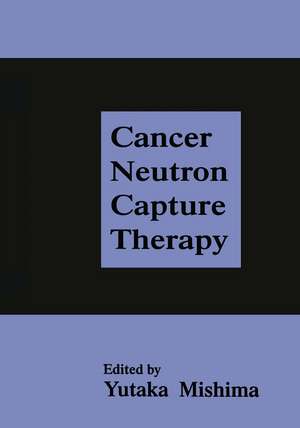Cancer Neutron Capture Therapy
Editat de Y. Mishimaen Limba Engleză Paperback – 17 mai 2013
Preț: 2115.56 lei
Preț vechi: 2226.90 lei
-5% Nou
Puncte Express: 3173
Preț estimativ în valută:
405.06€ • 421.79$ • 336.08£
405.06€ • 421.79$ • 336.08£
Carte tipărită la comandă
Livrare economică 14-28 februarie
Preluare comenzi: 021 569.72.76
Specificații
ISBN-13: 9781475795691
ISBN-10: 1475795696
Pagini: 952
Ilustrații: XXVII, 920 p.
Dimensiuni: 178 x 254 x 50 mm
Greutate: 1.62 kg
Ediția:Softcover reprint of the original 1st ed. 1996
Editura: Springer Us
Colecția Springer
Locul publicării:New York, NY, United States
ISBN-10: 1475795696
Pagini: 952
Ilustrații: XXVII, 920 p.
Dimensiuni: 178 x 254 x 50 mm
Greutate: 1.62 kg
Ediția:Softcover reprint of the original 1st ed. 1996
Editura: Springer Us
Colecția Springer
Locul publicării:New York, NY, United States
Public țintă
ResearchCuprins
Selective Thermal Neutron Capture Therapy of Cancer Cells Using Their Specific Metabolic Activities-Melanoma as Prototype (Y. Mishima). Recent Results with Liposomes as Boron Delivery Vehicles for Boron Neutron Capture Therapy (M.F. Hawthorne et al.). Preparation of Epidermal Growth Factor Conjugates Aimed for Boron Neutron Capture Therapy (L. Gedda et al.). Epidermal Growth Factor (EGF) as a Potential Targeting Agent for Delivery of Boron to Malignant Gliomas (J. Capala et al.). Boron Neutron Capture Therapy against Tumor Cells with Overexpression of the EGFreceptor (J. Carlsson et al.). Boronrich Oligophosphates: Novel Molecules for Use in BNCT (R.R. Kane et al.). Potential Use of Bispecific Antibodies (BSABS) for Targeting Gliomas and Melanomas (L. Liu et al.). Effect of Intratumoral Injection of 10Bimmunoliposome on BNCT for Growth Inhibition of Human Pancreatic Cancer Grafts in Nude Mice (H. Yanagie et al.). Chemical Modeling with pboronphenylalanine for Boron Accumulation to and Release from Melanoma (K. Yoshino et al.). Chemical Properties of p, m, oboronophenylalanine (K. Yoshino et al.). An Efficient Synthesis of pboronphenylalanine and Its Homologues by the Reaction of Ethyl Isocyanoacetate with a pformylbenzeneboronic Acid Derivative (M. Kirihata et al.). 115 additional articles. Index.
